New Jersey is a relatively flat state, with beautiful shores and a few rugged hills. Its coastline is home to the lowest point in the state, where the vast Atlantic Ocean meets its shores. While the Atlantic Ocean is widespread across the East Coast, it holds immense significance for New Jersey’s history, culture, and recreational opportunities. Let’s delve into the fascinating aspects that make the Atlantic Ocean along New Jersey’s coast a special and cherished destination.
Historical Significance and Coastal Heritage of Atlantic Ocean
The historical significance of the Atlantic Ocean in shaping New Jersey’s identity is deeply rooted in its maritime heritage. The state’s coastal regions were witnesses to pivotal moments in history. But they were also active participants in the development of trade, industry, and culture in the state. Explorers and settlers arrived on the shores of New Jersey with dreams of discovery and prosperity. The Atlantic Ocean provided a gateway to new opportunities, connecting the region to other parts of the world.

A
snowy owl
snoozes on a dune at Island Beach State Park in New Jersey. New Jersey is known for its beaches along the Atlantic, which are sandy and beautiful.
©Susan L. Angstadt/Shutterstock.com
European Explorers and Colonial Era
During the Age of Exploration, European navigators like Henry Hudson and Giovanni da Verrazzano sailed across the Atlantic Ocean. They also anchored their ships along what is now New Jersey’s coastline. Hudson’s exploration in the early 17th century led to Dutch claims on the region. Therefore, they established New Amsterdam, which is present-day New York City, as a fur trading post. This Dutch influence extended to areas like Bergen, New Jersey’s first European settlement. As trade routes flourished, coastal towns like Cape May and Atlantic City also became important ports for ships to replenish supplies and conduct commerce.
Revolutionary Spirit and Maritime Industry in the Atlantic Ocean
The Revolutionary War also infused the coastal areas with a spirit of patriotism and resistance. The proximity to the Atlantic Ocean enabled New Jersey’s residents to play a vital role in the war effort. They did this by utilizing privateer ships to disrupt British naval operations which ensured the success of the American cause. Access to sea also fostered the maritime industry, including shipbuilding, fishing, and whaling. Coastal towns also developed a symbiotic relationship with the ocean, with their livelihoods dependent with its resources.
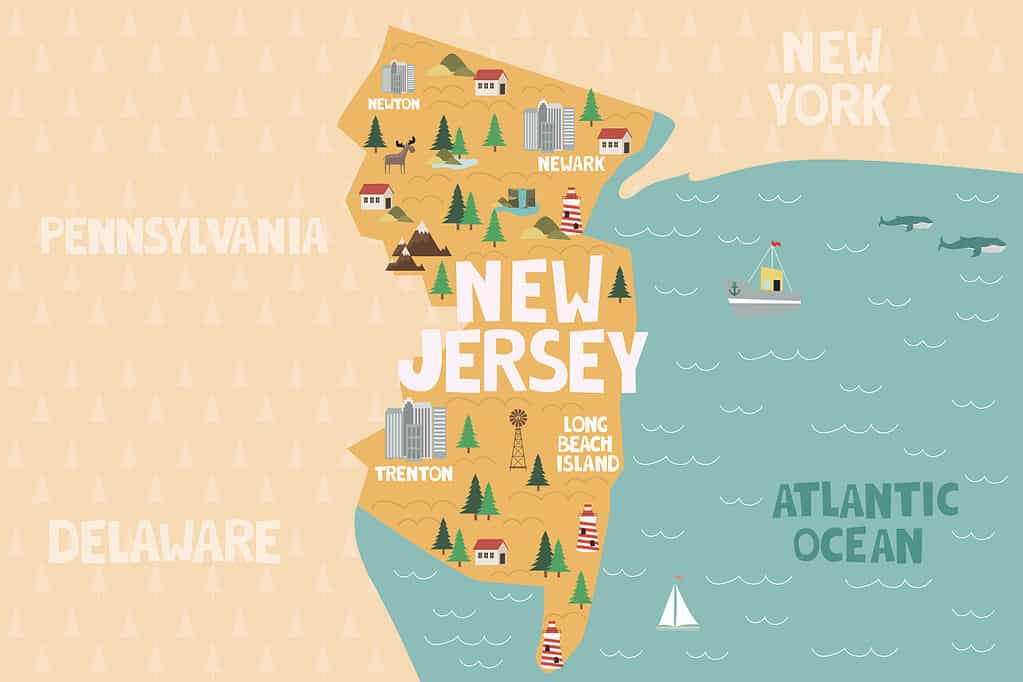
A map of the state of New Jersey in United States with cities and landmarks. New Jersey borders the Atlantic Ocean on the east and south.
New York
borders it on the north, while
Pennsylvania
and
Delaware
share a border in the west.
©iStock.com/BonneChance
Cultural Exchange
As the nation grew, New Jersey’s Atlantic coast continued to evolve. The construction of lighthouses along the coastline served as both beacons of safety for mariners and symbols of progress. Lighthouses like Sandy Hook Light and Cape May Lighthouse have also stood on the coast for generations. They are not only important historical beacons but still guide ships through treacherous waters. They also inspire future generations to appreciate the ocean’s grandness. Additionally, the coastal areas welcomed diverse waves of immigrants. This has lead to a melting pot of cultures in the state that diversifies the New Jersey’s heritage.
Today, remnants of this rich maritime heritage are still woven into the fabric of New Jersey’s coastal towns. Historic districts, preserved buildings, and maritime museums stand as reminders of the state’s connection to the Atlantic Ocean. Visitors can also explore historic sites like the Absecon Lighthouse, which offers panoramic views of the ocean and surrounding area. Coastal heritage is also celebrated through events, festivals, and cultural initiatives that honor the traditions of fishing, shipbuilding, and seafaring.
Fun Things to Do Along New Jersey’s Coastline
New Jersey’s Atlantic Ocean coastline is a treasure trove of experiences and attractions. From sandy shores to vibrant boardwalks, the Atlantic Ocean offers a plethora of fun activities contribute to its unique charm.
Sandy Shores and Boardwalks
New Jersey’s expansive coastline has some of the most picturesque and inviting sandy shores on the Eastern Seaboard. These beaches are more than just places to soak up the sun. They are also special gathering spots for families, friends, and visitors seeking relaxation and recreation. The gentle lapping of waves against the shore and the endless horizon create a tranquil ambiance that rejuvenates the soul.
The iconic boardwalks that line the coast are where the past and present seamlessly intertwine. As visitors stroll along these wooden walkways, they feel transported to an era of old-fashioned amusements, vibrant entertainment, and sweet treats. The Atlantic City Boardwalk, one of the most famous in the world, is an embodiment of this spirit, with its historic Steel Pier and an array of attractions that attract visitors of all ages.

An aerial view of beach goers in Asbury Park, New Jersey on Memorial Day Weekend in 2019. New Jersey’s picturesque beaches invite those who require some old-fashioned vibes and fun.
©Sky Cinema/Shutterstock.com
Whale Watching and Marine Life
The Atlantic Ocean’s teeming marine life also offers breathtaking spectacles to those who venture offshore. One of the most captivating experiences is whale watching. This is where visitors can witness the incredible sight of majestic humpback whales breaching the surface amidst shimmering cascades of water. The migration patterns of these marine giants create opportunities for unforgettable encounters, allowing observers to appreciate the grandeur of these creatures in their natural habitat. The dance of dolphins alongside boats is also a frequent occurrence. It is even more delightful when these intelligent mammals showcase their playful acrobatics. For wildlife enthusiasts, this is an immersion into a world where the ocean’s inhabitants take center stage, offering glimpses into their hidden lives beneath the waves.
Beach Culture and Festivals
The Atlantic Ocean has shaped New Jersey’s beach culture for centuries. Residents celebrate this through a myriad of festivals and events that honor its influence. The Wildwood International Kite Festival, held annually in the picturesque town of Wildwood, transforms the sky into a kaleidoscope of colors as kites of all shapes and sizes fill the air.
This vibrant event carries the joy and creativity that has been inspired by the ocean and brings families together for a day of shared delight. Meanwhile, the Cape May Music Festival serenades audiences with performances that resonate across the waves, mimicking the ocean’s melody. These festivals reflect the sense of community that flourishes along the coast, where the ocean’s beauty fosters a unique bond among both residents and visitors.

A fence along a cloudy beach on Long Beach Island, New Jersey. The sand dunes along the beach are reflective of the Atlantic Ocean’s influence and are frequently visible along New Jersey beaches.
©Carolyn Cochrane/Shutterstock.com
Visitor Numbers and Recreational Activities in New Jersey Coast
New Jersey’s Atlantic Ocean coastline is also a magnet for visitors. It draws people from near and far to experience its natural beauty and engage in many recreational activities. From water sports to leisurely strolls along the shore, the ocean offers endless opportunities for enjoyment and relaxation.
Tourism Magnet
The allure of New Jersey’s Atlantic Ocean beaches has made them a top destination for tourists seeking sun, surf, and sand. The state’s proximity to major metropolitan areas like New York City and Philadelphia also enhances its appeal, making it a convenient getaway for city dwellers who seek an escape from the urban hustle. During the summer months, the beaches also come alive with an influx of visitors eager to soak up the sun. They take refreshing dips in the ocean and enjoy a range of beachside amenities.

A panorama of beach with Cape May Lighthouse in Cape May, New Jersey.
©karenfoleyphotography/Shutterstock.com
Water Sports and Activities
The Atlantic Ocean also provides the perfect variety of water sports and activities that cater to all levels of enthusiasts. Surfing is particularly popular along the coast. This is because the ocean waves attract beginners and seasoned surfers alike. Kayaking and paddleboarding also offer a unique perspective, allowing individuals to explore the tranquil waters and admire the coastline from a different angle. Fishing is another beloved pastime, with anglers casting lines from piers, jetties, and boats to reel in a diverse range of fish species.
Family-Friendly Adventures
New Jersey’s Atlantic Ocean beaches are also renowned for their family-friendly atmosphere. The stretches of sandy shore create playgrounds for building sandcastles, flying kites, and playing beach volleyball. Boardwalks are also adorned with amusement rides, arcades, and ice cream parlors. They are cherished by families seeking a nostalgic escape reminiscent of the past and often become a family tradition for many during summers. These boardwalks also become hubs of laughter and memories, where children and adults alike indulge in carefree fun.
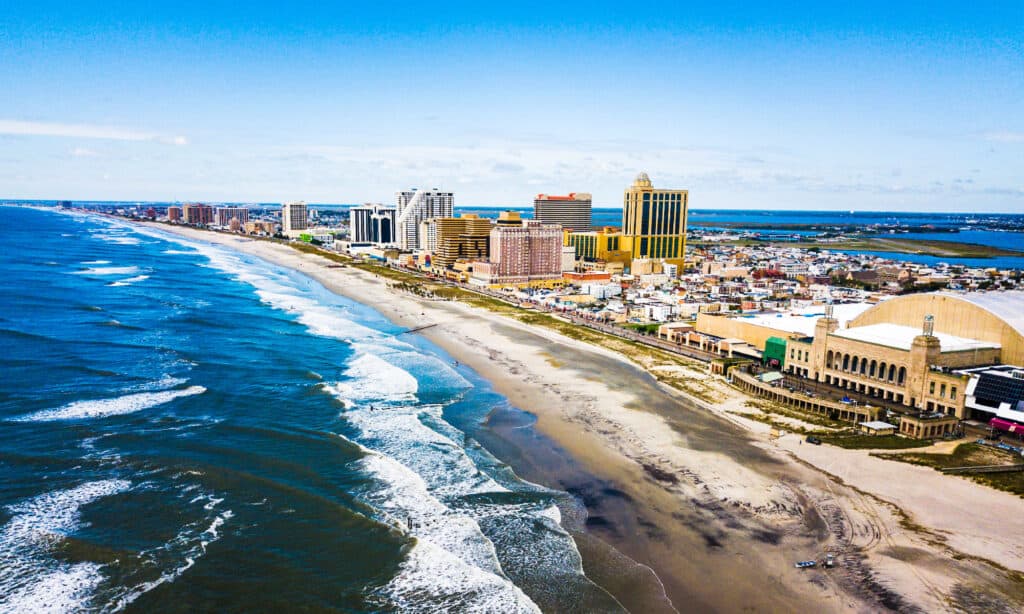
Winters can be bitterly cold and summers sweltering hot in New Jersey. However, near the ocean, the temperatures are always more controlled, which makes beaches delightful, no matter what the season is.
©iStock.com/Creative-Family
Wildlife Observation
The Atlantic Ocean’s shoreline also provides a unique opportunity for wildlife observation. It enriches the coastal experience with glimpses of native fauna. Seagulls and sandpipers dart across the sands, scavenging for foods and detritus left behind by the tides. Coastal dunes and marshes are also habitats for a variety of bird species, making birdwatching a rewarding endeavor for nature enthusiasts. The ocean’s expanse also hosts occasional marine visitors such as dolphins and seals, who attract onlookers with their playful antics.

An eastern
box turtle
in New Jersey.
©Breck P. Kent/Shutterstock.com
Photography and Sunset Views
The Atlantic Ocean’s ever-changing landscape is the perfect paradise for photographers and those who enjoy sunsets. The interplay of light and water creates mesmerizing scenes that shift from sunrise to sunset. As the sun dips below the horizon, the sky is painted with a kaleidoscope of colors. Photographers and romantics gather along the shoreline to capture these fleeting moments and make lasting memories.
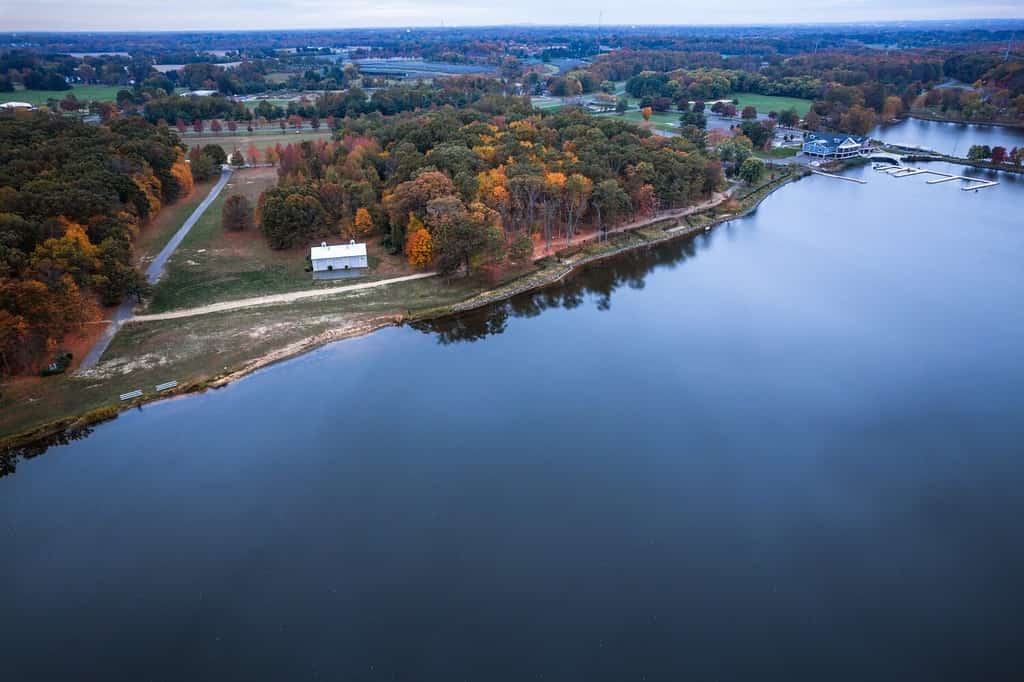
An aerial drone captures the foliage during sunrise in Mercer, New Jersey. New Jersey has some of the most beautiful shores in the country.
©FotosForTheFuture/Shutterstock.com
Marine Life and Biodiversity in Atlantic Ocean
We know that New Jersey’s Atlantic Ocean coastline is not only a playground for residents but is also a haven for a diverse array of marine life. The oceans teem with several diverse creatures, from the smallest plankton to the largest marine mammals. This dynamic ecosystem supports a complex food web, where each species plays a crucial role in maintaining the balance of life beneath the waves.
Marine Mammals
The Atlantic Ocean off New Jersey’s coast is home to several species of marine mammals. Dolphins are a common sight, often seen leaping and riding at the edge of boats. These intelligent and playful creatures perform acrobatics, which are delightful to see for adults and kids. Humpback whales, known for their mesmerizing breaches and haunting songs, are another highlight. These gentle giants undertake an annual migration that brings them to the region, offering lucky observers a chance to witness their majestic beauty up close.
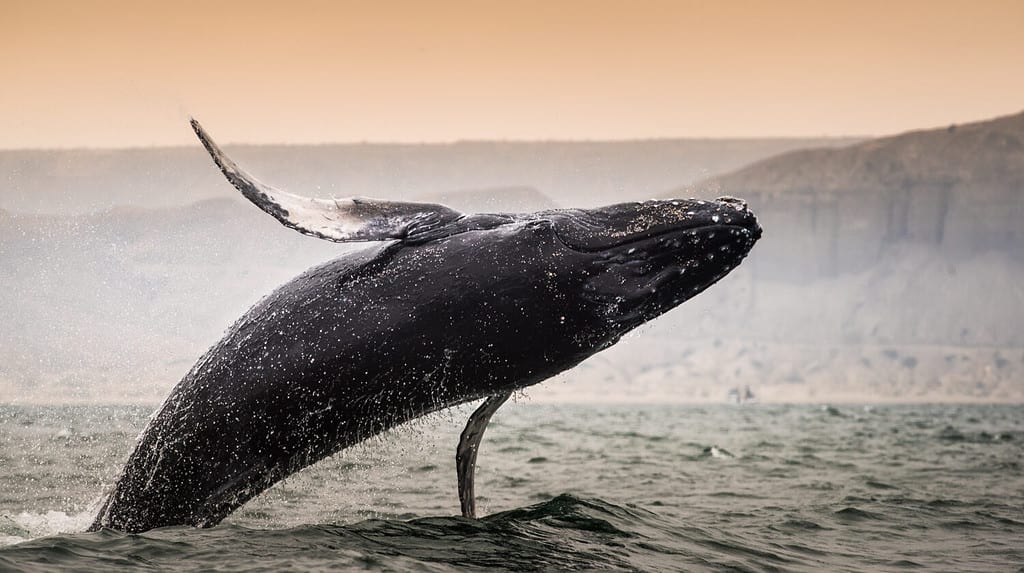
The
humpback whale
is a beloved resident of the New Jersey Atlantic shores. Whalewatching is a popular activity across the coasts of New Jersey.
©Christian Vinces/Shutterstock.com
Seabirds and Coastal Avian Residents
The coastline also serves as a vital habitat for numerous seabirds and coastal avian species. Gulls, terns, and sandpipers can be spotted gracefully navigating the shoreline as they fly in search of food. Nesting colonies of ospreys, also known as “fish hawks,” are beautiful to watch as they swoop down to catch fish and return to their nests. Therefore, the Atlantic Ocean’s proximity ensures a consistent food source for these avian residents.
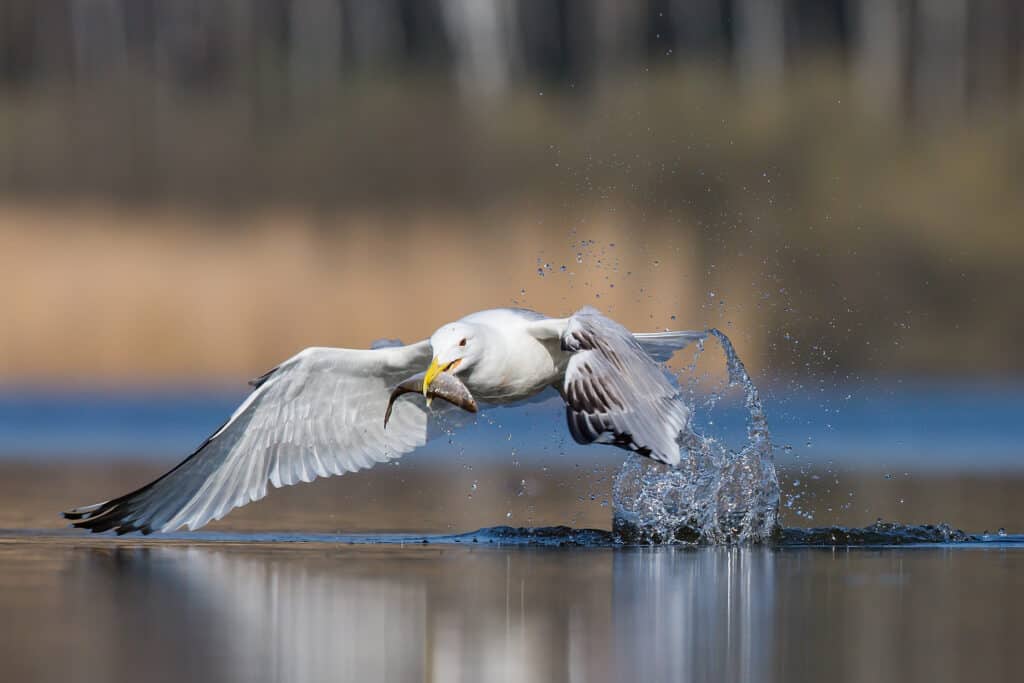
Seagulls are sometimes considered annoying and aggressive birds. But they can be beautiful to watch as they swoop down to grab fish and other food.
©Lukas Pavlacik/Shutterstock.com
Environmental Conservation and Ecosystem in New Jersey
The Atlantic Ocean has a profound impact on New Jersey’s ecosystem. It is a source of recreation and wildlife habitat. Therefore, the state is committed to environmental conservation through efforts to protect and sustain the ocean’s delicate balance.
Coastal Erosion and Dune Restoration
The Atlantic Ocean’s waves have the power to shape and reshape the coastline through processes of erosion and sediment deposition. Coastal dunes, therefore, play a critical role in protecting inland areas from storm surges and act as natural buffers against erosion. Thus, some of New Jersey’s conservation initiatives focus on dune restoration and protection. Planting dune grasses helps stabilize sand and prevent erosion, contributing to the overall health of the coastline and its resilience to natural forces.

New Jersey frequently plants dune grasses across the landscape to prevent erosion of dunes, which protect the coasts from storm surges.
©Gavin F/Shutterstock.com
Marine Reserves and Protected Areas in New Jersey
New Jersey’s commitment to marine conservation is also visible through the establishment of marine reserves and protected areas. These designated zones are designed to preserve fragile ecosystems and marine habitats. The intent is to allow these areas to recover and thrive without the pressures of human activities like fishing and development. By safeguarding these spaces, the state ensures the long-term health and biodiversity of the ocean’s resources.
Balancing Tourism and Conservation
However, the popularity of the New Jersey coastline also poses the unique challenge of balancing tourism with conservation efforts. As visitors flock to the beaches for recreation and enjoyment, careful management is necessary to prevent negative impacts on the ecosystem. Education, awareness campaigns, and responsible tourism practices therefore contribute to the conservation of marine habitats while allowing people to enjoy the ocean sustainably.
In conclusion, the Atlantic Ocean’s relationship with New Jersey extends far beyond its role as a body of water. It’s an anchor that connects the state to its colonial past, is a source of recreational enjoyment, and also is a vital contributor to the region’s natural ecosystem. Whether you’re strolling along a boardwalk, watching dolphins leap in the waves, or simply enjoying the tranquil rhythm of the tides, the Atlantic Ocean is and will always remain an intrinsic part of New Jersey’s heart and soul.
Thank you for reading! Have some feedback for us? Contact the AZ Animals editorial team.








